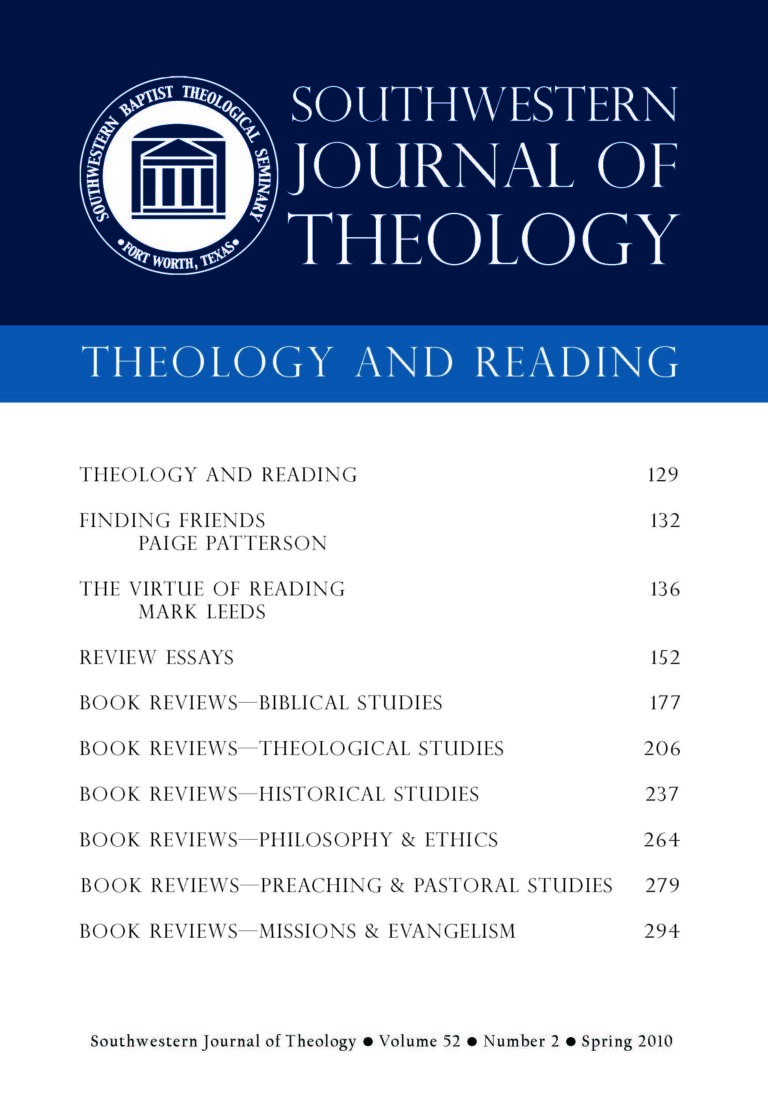
Theology and Reading
Southwestern Journal of Theology
Volume 52, No. 2 – Spring 2010
Managing Editor: Malcolm B. Yarnell III
By Anthony Thiselton. Grand Rapids: Eerdmans, 2007. 671 pages. Hardcover. $46.00.
Anthony Thiselton’s The Hermeneutics of Doctrine makes a significant contribution to the perennial discussions on theological methodology. Thiselton’s previous works on philosophy, hermeneutics and biblical exegesis all serve as reservoirs from which he draws for his wide-ranging comments on the purpose, content and value of doctrinal methodology. His insights reflect both the density and articulacy that the reader anticipates from Thiselton.
Thiselton divides the work into three uneven parts. Part one sets the framework or presuppositions from which the third part will be developed. Thiselton finds a “dispositional” quality to early Christian confessional statements including the ones found in the New Testament. He argues that the hermeneutics of doctrine extends this dispositional quality because of its twin values of coherence and particularity. Thiselton argues that “communal belief-utterances are no less closely embedded in life-situations and actions (italics his) than are the expressions of individual belief.” (43) He also notes that dispositional utterances are often relayed in a narrative framework and have an ultimate goal of formation and perhaps transformation.
Part two, the briefest of the three, provides Thiselton’s response to anticipated objections to his methodology or presuppositions. He downplays the contrast between coherence and contingency in hermeneutics and doctrine. He cites that scholars on both sides of the biblical studies and theological studies divide have overdrawn the tension between the universality of doctrinal truth and knowledge (e.g. epistemology) and particularity in doctrine expression (e.g. the confessions of a particular community). Drawing on the dialogic nature of truth as expressed in language (Bahktin), the “scientific” aspects of theology from Torrance and formative/transformative aspects of understanding (Lonergan), Thiselton proposes that hermeneutics in doctrine best accounts for the communal and personal qualities of theology.
Part three, the longest part by far (over 400 pages), discusses the issues related to attempting to frame doctrine along the lines that Thiselton has established. He provides some general direction for developing and expressing doctrine in his hermeneutical terms without attempting to provide a new, comprehensive systematic theology. In this part, Thiselton continues his style of a critical discussion of scholarship on the central areas of doctrine. For example, on the church and ministry, Thiselton uses Avery Dulles’ models of the church and the “one, holy, catholic and apostolic” of the Nicene Creed to frame his ecclesiological discussion. The resulting discussion tries to present a picture that blends Dulles’ models in attempt to fulfill the pattern the Creed provides for the church. The church must have a definitive shape and purpose (its theological aspect) without allowing its structure (its institutional aspect) to become self-serving emanating triumphalism.
The most intriguing aspect of part three is perhaps that Thiselton uses humanity as the foundational theological tenant from which to develop the other aspects of theology instead of the doctrine of God or Scripture as some might anticipate. By starting with humanity, Thiselton is able to stress the quality of relationality as central to being human. Relationality initiates the language possibilities for the communication of theological truths, it allows for the God-human relationship to be explored as an expression of divine love and it provides the communal context for the expression of Christian belief.
Some readers may criticize Thiselton for his dense writing style or for his unwillingness to develop a comprehensive expression of doctrine using his hermeneutical framework. However, other recent works that have attempted to integrate philosophy of language, hermeneutics, biblical exegesis, and theological formulation to the level that Thiselton has have also shown the tension between lucidity and erudition (e.g. Vanhoozer’s Drama of Doctrine). Developing a new form of expressing doctrinal commitments is no small achievement though it may require others to complete the task of applying this form of expression to all the doctrinal categories.
On a personal note, in the “Acknowledgements”, Thiselton’s wife, Rosemary notes that he had suffered a major stroke in the final days of preparing the manuscript. Earlier this year, Scot McKnight reported in his review of this book in Christianity Today that Thiselton had experienced a remarkable recovery.





